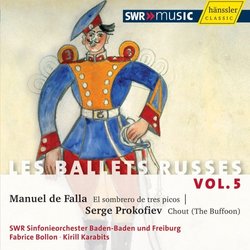| All Artists: Manuel de Falla, Sergey Prokofiev, Fabrice Bollon, Kirill Karabits, SWR Baden-Baden and Freiburg Symphony Orchestra, Ofelia Sala Title: De Falla: El Sombrero de Tres Picos; Prokofiev: The Buffoon Members Wishing: 0 Total Copies: 0 Label: Hanssler Classics Original Release Date: 1/1/2009 Re-Release Date: 10/13/2009 Album Type: Import Genre: Classical Styles: Ballets & Dances, Ballets Number of Discs: 1 SwapaCD Credits: 1 UPC: 4010276022442 |
Search - Manuel de Falla, Sergey Prokofiev, Fabrice Bollon :: De Falla: El Sombrero de Tres Picos; Prokofiev: The Buffoon
 | Manuel de Falla, Sergey Prokofiev, Fabrice Bollon De Falla: El Sombrero de Tres Picos; Prokofiev: The Buffoon Genre: Classical
When de Falla wrote "The Three-Cornered Hat" in 1916-1919 (after a story by Pedro Antonio de Alarcón), he was already a well-known composer. The first version, developed as a Pantomime, Diaghilev saw in Madrid and the... more » |
Larger Image |
CD Details
Synopsis
Album Description
When de Falla wrote "The Three-Cornered Hat" in 1916-1919 (after a story by Pedro Antonio de Alarcón), he was already a well-known composer. The first version, developed as a Pantomime, Diaghilev saw in Madrid and then commissioned de Falla to develop his score into a ballet. The ballet was first performed in 1919 in London, conducted by Ernest Ansermet with set designs and costumes by Pablo Picasso. The final score was a marvelous work, one of de Falla's most beautiful, and it is presented here in its entirety. Prokofiev's "Chout" received its first performance in Paris 1921, where it was well received. The score, calling for a large orchestra, is richly melodic and has a typical Russian folkloric quality as well as the burlesque elements that would appear in many of Prokofiev's most famous works.

 Track Listings (20) - Disc #1
Track Listings (20) - Disc #1